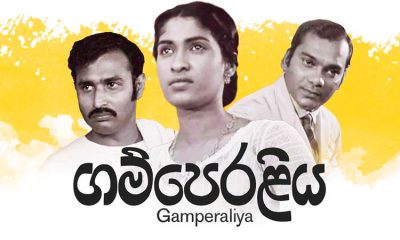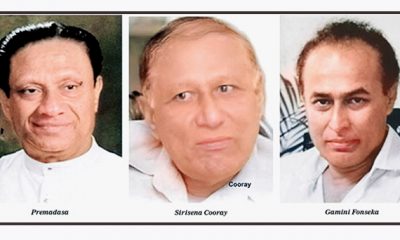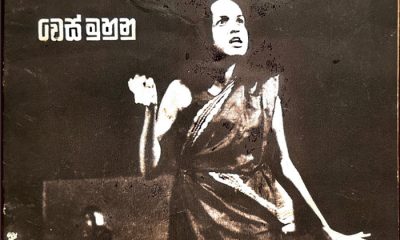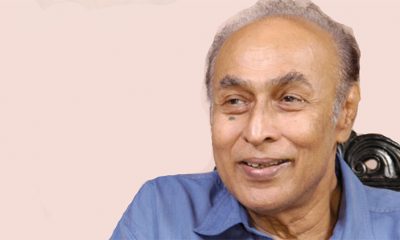Features
Popular Sinhala Cinema – III – Rukmani Devi; Mohideen Baig ; Gamini Fonseka
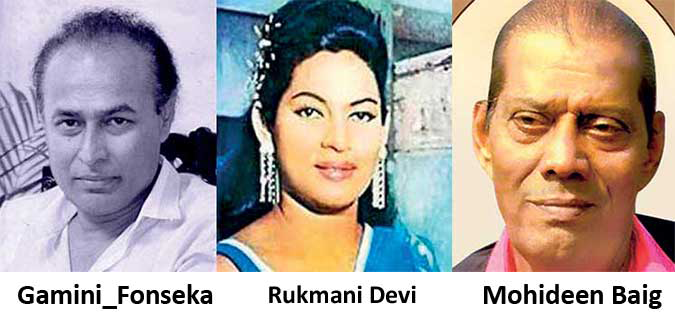
by Laleen Jayamanne
( Continued From Wednesday)
The Multi-Ethnic fan base
Gamini Fonseka, who introduced action (fights) with a new image of proletarian muscular masculinity into Sinhala cinema, was loved by both the Sinhala and Tamil male films fans for those reasons. His film Sarungale, where he played a rather sedentary Tamil Clerk (he spoke Tamil), was especially significant in this cross-cultural context. I read an account of how Tamil fans surrounded him on a platform once, when he got off the Jaffna train to stretch his legs, while returning from the film shoot there. He is that rare Sinhala artiste who spoken of wanting to appeal to the Tamil audience as well.
I have read that Gamini visited Tamil cinema halls with his cinematographer to observe the responses of the fans to Indian super stars. The super star Gamini Fonseka’s film persona as well as his ethical values must be remembered here. When Gunaratnam was murdered there was fear that it was too dangerous to attend his funeral as one might also be targeted by the JVP. Siva Sivanathan who worked for Gunaratnam described how Gamini insisted on walking in the funeral procession with the family, to honor this visionary film producer who had contributed greatly to the development of Lankan cinema and industrial development more broadly and built so many bridges between the North and the South.
Siva Sivanandan’s long experience as a film director and distributor for Gunaratnam was appreciated by Nihalsinha, the General Manager of the SFC who then hired him as Assistant General Manager of the vital revenue generating distribution wing of the new institution. He worked with great success for ten years, before emigrating to Canada with his family. Somasiri Munasinghe, in his tribute to Svianandan after his recent death, says that he left behind a whole library of publications, rare journals, news-paper clippings, etc, all linked to the Lankan film industry and multi-ethnic history from its beginning.
In another country this invaluable collection would have been swiftly obtained by a university library in the interest of future research. I am hoping that it’s still not too late for this to happen through a Lankan University. If that were to happen and along with oral history interviews with the several generations of older journalists who grew up with those film songs and films or rediscovered them laters, then we might get a more nuanced understanding of what has been achieved by our robust and dedicated multi-ethnic artists and technicians, working together under great odds.
Understanding the historical diversity of Lankan popular hybrid traditions of mass culture especially, can offer a corrective to the darker and violently self-destructive actions of virulent Sinhala Nationalism pursuing cultural purity and burning down cinemas and studios owned by Tamils and in the process also destroying a large number of their own Sinhala films stored in these very studios.
These acts of profound violence are not simply the work of crazed mobs, as some say. They are simply the impoverished, poorly educated lumpen proletariat mostly, given electoral roles identifying Tamil property. They are the weaponised end in a long chain of command, activated by nationalist state policies and ideology of an ethno-nationalist state. This deeply rooted ideology treats minorities as second class citizens, a threat to the majority and therefore not part of the culture.
Sound of Pure Sinhala Bera
Ethnomusicological research into Lankan music, by foreign scholars and locals alike tend to follow the official ethno-nationalist narrative of a ‘Pure, Original Sinhala’ sound, say as in Kandyan drumming. It is then differentiated from the Southern, more hybridised Yakbera, for example. The researchers almost completely ignore the decisive influence of mass culture (Nurti plays, the vast reach of radio, gramophone records, films, cassettes, Television and the digital technology) in creating hybrid sonic worlds in this small island nation from the early 20th Century for over one hundred years.
The intellectual and political project of creating ‘pure traditions or apema sindu, rendered in the one correct, pure accent, (swara) of the Sinhala folk, their language and religion or music and films, ends up freezing traditions from evolving. Traditions need replenishing by being open to outside influences. Sound, even more than language itself, is fluid, never stable, given that the speed of sound (though not as fast as light), has the power to instantly penetrate us and vibrate our very nervous system directly like our drumming does.
It’s important to remember the historically informed important words of W.D. Amaradeva who, as a young violinist named Albert Perera, went to India with Baig Master and others to record music for Asokamala. This exposure led him to spend five years in India studying classical vocal raga music and the violin with a guru. It is after this rigorous training that he reinvented himself as Amaradeva. He said:
“Although we had a good folk culture, we did not have a developed musical tradition of our own. We did not have local musical instruments to play a melody even though we had a rich percussion tradition in Sri Lanka in the form of bera (drums).
But all instruments like the sitar, tabla and violin came from other countries. I wanted to fill this void. So, I started composing music for my country […] yet one cannot help being influenced by other types of music as well”.
Ranjith Kumara informed us that Baig Mater’s singing of Siri Buddhagaya was regularly heard all over the country, across villages and towns during Vesak and Sinhala new year festivities, played on the humble cassettes or blaring out on microphones at dansalas. Unlike Rukmani Devi’s voice, Baig Master’s voice was unmistakably accented with sonic traces of his mother tongue Urdu. And it remained so to the end. Would it not also be good then to hear Rukmani Devi sing that one Tamil song she is said to have recorded in a Tamil film and also hear Baig Master sing in Urdu or Tamil or HIndi (if there is a recording), during a national festive occasion? Perhaps at the Fourth of February independence celebration at Gall Face; a hybrid sonic gesture of reconciliation sanhindiyawa, mingling with the sounds of the Indian ocean.
After all, Baig Master did sing in Sinhala, at the 1948 Independence Day celebrations, with a sense of freedom in the air. This contemporary idea of ‘reconciliation’ was first created in South Africa after the white supremacist apartheid regime was defeated. But there was an allied concept essential to it, namely, ‘truth- telling’. The African leadership with Nelson Mandela thought there could be no reconciliation after such racial violence, without also acknowledging it truthfully and redressing the violence.
A Few Home-Truths
1.Sinhala Nationalists protested when the then Education Minister Badiuddin Mohamed arranged Baig Master to sing at the Non-Aligned Conference, saying he was not a Sinhala-Buddhist. When the minister threatened to resign, Mrs Bandranayake permitted him to sing to the gathering of world leaders among whom were Colonel Gaddafi, and other Arab and African Muslim leaders who received his Bodu Gee warmly.
2. When Baig Master performed for the Pakistani President Zia Ul Hak, he was so impressed that he wanted to take him back to Pakistan. When President Premadasa declined the offer, Zia arranged a tour in Pakistan for Master Baig.
3. He lived in a tiny overcrowded house and slept on the floor for forty years. As he lay dying in hospital, consoling his son Ishak, he had noted lightly that he finally had a bed!
It’s also worth reminding ourselves that D.S. Senanayaka (who later became the first Prime Minister), was the chief guest at the premier of Kadawuna Poronduwa (in January 1947 at the Kingsley cinema), as Minister of Agriculture and Lands and also Leader of the House under the State Council system of governance during the last stages of British rule. His presence along with business leaders denoted the importance of the event for Ceylon on the cusp of independence. Rukmani Devi, Eddie and BAW Jayamanne brothers and Mr Nayagam were celebrated for having dared to have produced the first film in Sinhala, under daunting conditions in India.
While the critics deplored the film’s dependence on Indian genres, the people, more receptive, gathered to see and hear it. It was screened in four cinemas in Colombo and in a large number of outer suburbs, while in Kandy, bus-loads of people arrived to view this historic film in a tent specially erected for the screening. Political patronage, Tamil entrepreneurship, Sinhala intellectual high disdain and robust popular mass appeal, were the jostling forces at play with the arrival of a multi-ethnic Lankan cinema and its film culture.
The journalist-cinephiles on the ITN programs were unanimous in their view that both Rukmani Devi and Baig Master did not receive the care and support they deserved as figures of national (and even Indian) recognition, especially during the vulnerable later stages of their lives. While issuing stamps in their honour is a good thing, it is quite insufficient, given the magnitude of the reach of their haunting voices which still resonate politically as well. But Amaradeva and others who created a Sinhala light classical tradition, combining the rich Indian raga melodic patterns with folk songs, received generous state patronage.
Baig Master’s song Buddhan Saranan Gachchami, with lyrics by Karunarathne Abeyesekera and music by Anil Bishwar (an Indian), was 12 mins and 45 seconds long and was first performed in the Hindi film Angulimala, funded by the Thai government. In Ceylon, it was dubbed into Sinhala and the local version of the song commissioned by Gunaratnam. The film was a major success and the song, one of the most frequently requested on Radio Ceylon, according to Ariyasiri Withanage.
He associated with him and arranged the many song recitals at which Master Baig was a popular attraction right across the Sinhala areas of the country, where most of the shows opened with this devotional song. Of the many Bodu Gee he sang this was the favourite. Some Buddhist priests valued him and engaged with him and attended his funeral. This singular song, a collaboration among Muslim, Hindu and Buddhist artists of India and Lanka, is an example of what can be created when we abandon the stifling dead-end idea of ‘cultural purity’ promulgated by the ethno-nationalist state.
Listening now (after the Aragalaya), to the voices of Rukmani Devi and Baig Master singing love duets and shoka gee in those sweetly naive films (Sarala chithrapata) of the early Sinhala cinema just might resonate in a different way (if freed of high critical disdain), suggestive of our intricate cultural interconnections with India.
Al Haj Mohideen Baig and Rukmani Devi, in their highly skilled capacity to cross-sonic traditions and cultures and create hybrid fields of music touching our hearts and minds (hurda gochara and bhuddhi gochara songs, in the wonderful coinage of Ranjan de Silva), are exemplary artists for a confidently multi-ethnic Lanka open to the many creative influences of the sonic worlds at large. (Concluded)
Features
SL urged to use GSP+ to the fullest to promote export development
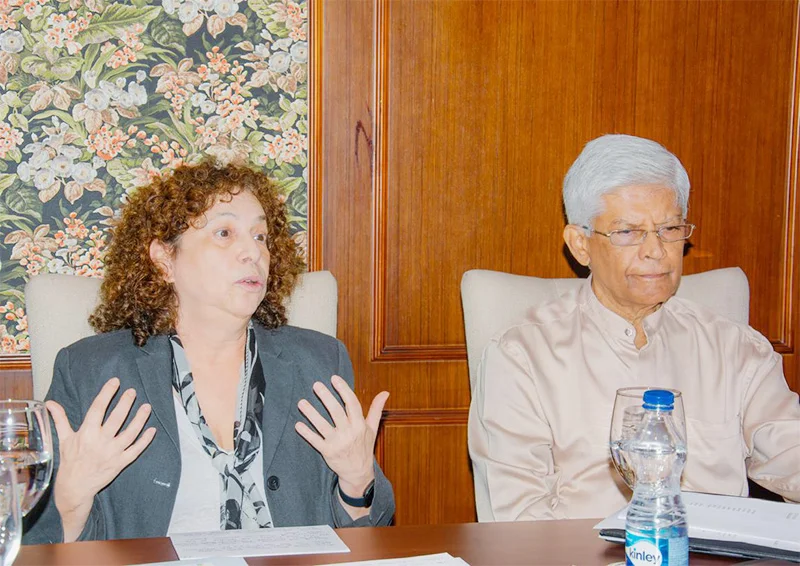
 Sri Lanka needs to take full stock of its current economic situation and use to the maximum the potential in its GSP+ facility for export sector growth. In the process, it should ensure that it cooperates fully with the European Union. The urgency of undertaking these responsibilities is underscored by the issues growing out of the recent US decision to sweepingly hike tariffs on its imports, though differentially.
Sri Lanka needs to take full stock of its current economic situation and use to the maximum the potential in its GSP+ facility for export sector growth. In the process, it should ensure that it cooperates fully with the European Union. The urgency of undertaking these responsibilities is underscored by the issues growing out of the recent US decision to sweepingly hike tariffs on its imports, though differentially.
These were principal ‘takes’ for participants in the Pathfinder Foundation’s Ambassadors’ Roundtable forum held on April 8th at the Colombo Club of the Taj Samudra. The main presenter at the event was Ms. Carmen Moreno Raymundo, Ambassador of the European Union to Sri Lanka and the Maldives. The forum was chaired by Ambassador Bernard Goonetilleke, Chairman, Pathfinder Foundation. The event brought together a cross-section of the local public, including the media.
Ms. Moreno drew attention to the fact Sri Lanka is at present severely under utilizing its GSP+ facility, which is the main means for Sri Lanka to enter the very vast EU market of 450 million people. In fact the EU has been Sri Lanka’s biggest trading partner. In 2023, for instance, total trade between the partners stood at Euros 3.84 billion. There is no greater market but the EU region for Sri Lanka.
‘However, only Sri Lanka’s apparel sector has seen considerable growth over the years. It is the only export sector in Sri Lanka which could be said to be fully developed. However, wider ranging export growth is possible provided Sri Lanka exploits to the fullest the opportunities presented by GSP+.’
Moreno added, among other things: ‘Sri Lanka is one among only eight countries that have been granted the EU’s GSP+ facility. The wide-ranging export possibilities opened by the facility are waiting to be utilized. In the process, the country needs to participate in world trade in a dynamic way. It cannot opt for a closed economy. As long as economic vibrancy remains unachieved, Sri Lanka cannot enter into world trading arrangements from a strong position. Among other things, Sri Lanka must access the tools that will enable it to spot and make full use of export opportunities.
‘Sri Lanka must facilitate the private sector in a major way and make it possible for foreign investors to enter the local economy with no hassle and compete for local business opportunities unfettered. At present, Lanka lacks the relevant legal framework to make all this happen satisfactorily.
‘Sri Lanka cannot opt for what could be seen as opaque arrangements with bilateral economic partners. Transparency must be made to prevail in its dealings with investors and other relevant quarters. It’s the public good that must be ensured. The EU would like to see the local economy further opening up for foreign investment.
‘However, it is important that Sri Lanka cooperates with the EU in the latter’s efforts to bring about beneficial outcomes for Sri Lankans. Cooperation could be ensured by Sri Lanka fully abiding by the EU conditions that are attendant on the granting of GSP+. There are, for example, a number of commitments and international conventions that Sri Lanka signed up to and had promised to implement on its receipt of GSP+ which have hitherto not been complied with. Some of these relate to human rights and labour regulations.
‘Successive governments have pledged to implement these conventions but thus far nothing has happened by way of compliance. GSP+ must be seen as an opportunity and not a threat and by complying with EU conditions the best fruits could be reaped from GSP+. It is relevant to remember that GSP+ was granted to Sri Lanka in 2005. It was suspended five years later and restored in 2017.
‘The importance of compliance with EU conditions is greatly enhanced at present in view of the fact that Sri Lanka is currently being monitored by the EU with regard to compliance ahead of extending GSP+ next year. A report on Sri Lanka is due next year wherein the country’s performance with regard to cooperating with the EU would be assessed. The continuation of the facility depends on the degree of cooperation.
‘A few statistics would bear out the importance of Sri Lanka’s partnership with the EU. For example, under the facility Sri Lanka benefits from duty free access in over 66% of EU tariff lines. The highest number of tourist arrivals in Sri Lanka in 2023 was from the EU’s 27 member states. Likewise, the EU’s 27 member states rank second in the origin of inflows of foreign exchange to Sri Lanka; with Italy, France and Germany figuring as the main countries of origin. Eighty five percent of Sri Lanka’s exports to the EU market benefits from GSP+. Thus, the stakes for the country are high.’
Meanwhile, President, In-house Counsel & Legal Advisor, The European Chamber of Commerce of Sri Lanka, John Wilson said: ‘GSP+ should be seen as not only an opportunity but also as a necessity by Sri Lanka in the current international economic climate. ‘Implementation of local laws is what is needed. Considering the pressures growing out of the US imposed new tariff regime, a good dialogue with the EU is needed.
‘Sri Lanka’s level of business readiness must be upped. Among the imperatives are: An electronic procurement process, Customs reforms, a ‘National Single Window’, stepped-up access to land by investors, for example, a clear policy framework on PPPs and reform of the work permits system.’
It ought to be plain to see from the foregoing that Sri Lanka cannot afford to lose the GSP+ facility if it is stepped-up economic growth that is aimed at. It would be in Sri Lanka’s best interests to remain linked with the EU, considering the aggravated material hardships that could come in the wake of the imposition of the US’ new tariff regime. Sri Lanka would need to remain in a dialogue process with the EU, voice its reservations on matters growing out of GSP+, if any, iron out differences and ensure that its national interest is secured.
Features
SENSITIVE AND PASSIONATE…
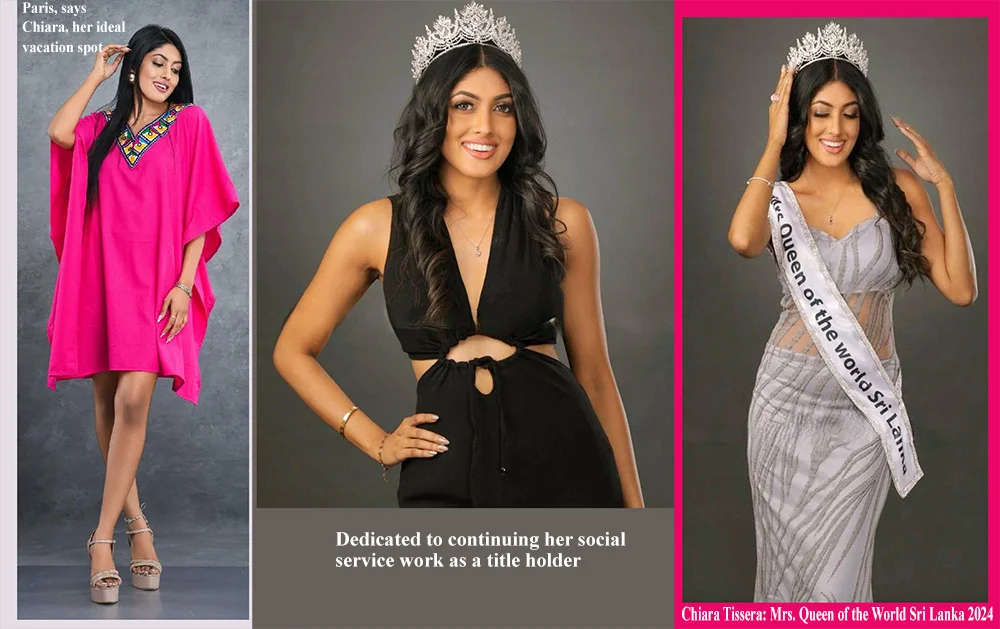
Chit-Chat
Chiara Tissera
Mrs. Queen of the World Sri Lanka 2024, Chiara Tissera, leaves for the finals, in the USA, next month
I had a very interesting chat with her and this is how it all went:
1. How would you describe yourself?
I am a sensitive and passionate individual who deeply cares about the things that matter most to me. I approach life with a heart full of enthusiasm and a desire to make meaningful connections.
2. If you could change one thing about yourself, what would it be?
Actually, I wouldn’t change a thing about myself because the person I am today, both inside and out, is the result of everything I’ve experienced. Every part of me has shaped who I am, so I embrace both my strengths and imperfections as they make me uniquely me.
3. If you could change one thing about your family, what would it be?
If there’s one thing I could change about my family, it would be having my father back with us. Losing him six years ago left a void that can never be filled, but his memory continues to guide and inspire us every day.
4. School?
I went to St. Jude’s College, Kurana, and I’m really proud to say that the lessons I gained during my time there have shaped who I am today. My school and teachers instilled in me values of hard work, perseverance and the importance of community, and I carry those lessons with me every day. I was a senior prefect and was selected the Deputy Head Prefect of our college during my tenure.
5. Happiest moment?
The happiest moment of my life so far has been winning the Mrs. Sri Lanka 2024 for Queen of the World. It was a dream come true and a truly unforgettable experience, one that fills me with pride and gratitude every time I reflect on it.
6. What is your idea of perfect happiness?
Happiness is a deeply personal and multifaceted feeling that often comes from a sense of contentment, fulfillment and well-being. For me, perfect happiness is in moments of joy, peace and accomplishments … and also being surrounded by my loved ones.
7. Are you religious?
Yes, I’m a very religious person. And I’m a firm believer in God. My faith guides me through life, providing strength, dedication and a sense of peace in every situation. I live by the quote, ‘Do your best, and God will do the rest.’
8. Are you superstitious?
I’m not superstitious. I believe in making my own decisions and relying on logic and faith rather than following superstitions.
9. Your ideal guy?
My ideal guy is my husband. He is compassionate, understanding and is always there to support me, no matter what. He’s my rock and my best friend – truly everything I could ever want in a partner.
10. Which living person do you most admire?
The living person I admire the most is definitely my mummy. Her strength, love and unwavering support has shaped me into who I am today. She is my role model and she inspires me every day with her wisdom and kindness.
11. Your most treasured possession?
My most treasured possession is my family. They are the heart of my life, providing me with love, support and strength. Their presence is my greatest blessing.
12. If you were marooned on a desert island, who would you like as your companion?
I would like to have my spouse as my companion. Together, we could make the best of the situation, supporting each other, sharing moments of laughter and finding creative ways to survive and thrive.
13. Your most embarrassing moment?
There’s quite a few, for sure, but nothing is really coming to mind right now.
14. Done anything daring?
Yes, stepping out of my comfort zone and taking part in a pageant. I had no experience and was nervous about putting myself out there, but I decided to challenge myself and go for it. It pushed me to grow in so many ways—learning to embrace confidence, handle pressure, and appreciate my own uniqueness. The experience not only boosted my self-esteem but also taught me the value of taking risks and embracing new opportunities, even when they feel intimidating.”
15. Your ideal vacation?
It would be to Paris. The city has such a magical vibe and, of course, exploring the magical Eiffel Tower is in my bucket list. Especially the city being a mix of history culture and modern life in a way that feels timeless, I find it to be the ideal vacation spot for me.
16. What kind of music are you into?
I love romantic songs. I’m drawn to its emotional depth and the way they express love, longing a connection. Whether it’s a slow ballad, a classic love song or a more modern romantic tune these songs speak to my heart.
17. Favourite radio station?
I don’t have a specific radio station that I like, but I tend to enjoy a variety of stations, depending on my mood. Sometimes I’ll tune into one for a mix of popular hits, other times I might go for something more relaxing, or a station with a certain vibe. So I just like to keep it flexible and switch it up.
18. Favourite TV station?
I hardly find the time to sit down and watch TV. But, whenever I do find a little spare time, I tend to do some spontaneous binge – watching, catching whatever interesting show is on at that moment.
19 What would you like to be born as in your next life?
Mmmm, I’ve actually not thought about it, but I’d love to be born as someone who gets to explore the world freely – perhaps a bird soaring across continents.
20. Any major plans for the future?
Let’s say preparing and participating in the international pageant happening in the USA this May. It’s an exciting opportunity to represent myself and my country on a global stage. Alongside this, I am dedicated to continuing my social service work as a title holder, striving to make a meaningful difference in the lives of others through my platform.
Features
Fresher looking skin …

 The formation of wrinkles and fine lines is part of our ageing process. However, if these wrinkles negatively impact appearance, making one look older than they actually are, then trying out some homemade remedies, I’ve listed for you, this week, may help in giving your skin a fresher look.
The formation of wrinkles and fine lines is part of our ageing process. However, if these wrinkles negatively impact appearance, making one look older than they actually are, then trying out some homemade remedies, I’ve listed for you, this week, may help in giving your skin a fresher look.
* Banana:
Bananas are considered to be our skin’s best friend. They contain natural oils and vitamins that work very perfectly to boost our skin health. Skincare experts recommend applying the banana paste to the skin.
Take a ripe banana and mash a quarter of it until it becomes a smooth paste. Apply a thin layer of the banana paste on your skin and allow it to sit for 15 to 20 minutes before washing it off with warm water.
* Olive Oil:
Olive oil works as a great skin protector and many types of research suggest that even consuming olive oil may protect the skin from developing more wrinkles. Olive oil contains compounds that can increase the skin’s collagen levels. Yes, olive oil can be used as a dressing on your salads, or other food, if you want to consume it, otherwise, you can apply a thin layer of olive oil on your face, neck and hands and let it stay overnight.
* Ginger:
Ginger serves to be a brilliant anti-wrinkle remedy because of the high content of antioxidants in it. Ginger helps in breaking down elastin, which is one of the main reasons for wrinkles. You can have ginger tea or grate ginger and have it with honey, on a regular basis.
* Aloe Vera:
The malic acid present in Aloe Vera helps in improving your skin’s elasticity, which helps in reducing your wrinkles. Apply the gel once you extract it from the plant, and leave it on for 15-20 minutes. You can wash it off with warm water.
* Lemons:
Lemons contain citric acid, which is a strong exfoliant that can help you get rid of your dead skin cells and wrinkles. Also, as an astringent and a cleansing agent, it helps to fade your wrinkles and fine lines. You can gently rub a lemon slice in your wrinkled skin and leave it on for 10-15 minutes. Rinse afterwards and repeat this process two to three times a day.
* Coconut Oil:
Coconut oil contains essential fatty acid that moisturises the skin and helps to retain its elasticity. You can directly apply the coconut oil, and leave it overnight, after gently massaging it, for the best results.
-

 Business3 days ago
Business3 days agoColombo Coffee wins coveted management awards
-

 Business5 days ago
Business5 days agoDaraz Sri Lanka ushers in the New Year with 4.4 Avurudu Wasi Pro Max – Sri Lanka’s biggest online Avurudu sale
-

 Features4 days ago
Features4 days agoStarlink in the Global South
-

 Business6 days ago
Business6 days agoStrengthening SDG integration into provincial planning and development process
-

 Business5 days ago
Business5 days agoNew SL Sovereign Bonds win foreign investor confidence
-

 Features1 day ago
Features1 day agoSri Lanka’s Foreign Policy amid Geopolitical Transformations: 1990-2024 – Part III
-

 Features4 days ago
Features4 days agoModi’s Sri Lanka Sojourn
-

 Midweek Review1 day ago
Midweek Review1 day agoInequality is killing the Middle Class



